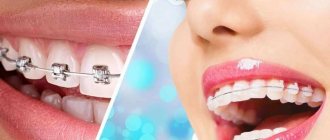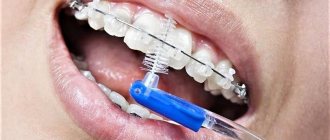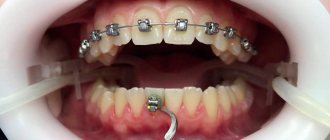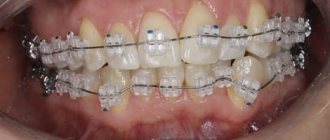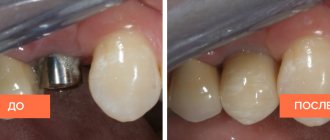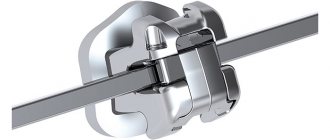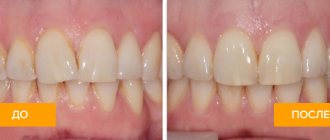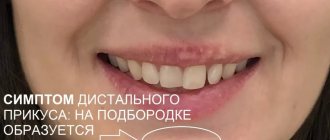Bite correction: how long does it take?
Already at the beginning of treatment, the orthodontist will tell you how long you need to wear braces - the real and maximum period of correction. The average is 1.5-2.5 years. Treatment time depends on a number of factors:
- Age of the patient - for accelerated correction, braces are placed immediately after the appearance of the main teeth of the permanent dentition.
- Bite pathology - the difficulty of correcting anomalies in the dentofacial rows directly affects the duration of treatment.
- The type and material of the orthodontic apparatus - treatment takes place differently on lingual and vestibular braces, on bracket systems made of medical sapphires, ceramics, and metal.
Braces: wearing time depending on pathologies
How long to wear braces depends directly on your bite. Orthodontists use a special classification according to Engel, where anomalies of the dentofacial rows are divided into three groups.
The first class includes minor defects. Wearing braces can restore the correct bite in 6-12 months for pathologies:
- medium-sized diastema - a gap between the front teeth;
- crowding of the front incisors - there is not enough space for the permanent teeth due to the insufficient size of the dental arch;
- trema – interdental spaces remaining after a complete change of bite;
- transposition, dystopia - tooth eruption in the wrong place.
Rodikova Tatyana
Serious bite corrections require not only correction of the position of individual teeth, but also the formation of jaw arches. That is why the process is lengthy and requires the use of rigid orthodontic arches, elastics, and numerous techniques.
Correction of a bite with the listed anomalies is quick, especially at a young age and with the correct selection of a brace system. If we compare how long a 13-year-old child needs to wear braces and an almost adult 18-year-old patient, then the speed of treatment in the first case will be higher.
Long-term wearing of braces will require pathologies belonging to the second and third classes. Among them are the types of bite:
- distal – the lower jaw is underdeveloped, and the upper jaw is too large;
- mesial – there is underdevelopment of the upper jaw with a lack of size of the lower jaw;
- open - some of the teeth do not close, which increases the load on the rest;
- deep – the lower teeth are hidden under the upper ones, completely covered by them;
- cross - the incisors cross when the upper and lower jaws meet.
Correcting the listed problems is more difficult, so wearing braces requires two to three years, followed by consolidation of the result for another 4-5 years.
At what age can aligners be used, features of their installation
The advantage of aligners is that malocclusion treatment with their help can begin as soon as the child is able to cooperate with the orthodontist. It is to cooperate, that is, to follow the recommendations of the attending physician consciously and without whims.
- Their installation is acceptable at 6-7 years of age. At this age, the tissues are plastic, the bite is corrected quickly.
- For children with baby teeth up to 12-13 years of age, only aligners and plates are suitable; an adult or teenager can choose mouth guards or braces and compare them.
Before making mouth guards, parents and their child come for a consultation, where impressions are taken or teeth are scanned, on the basis of which a 3D model is created and a step-by-step plan for correcting the bite is developed. Material – hypoallergenic polymer. If you do not examine the dentition very closely at close range, it is impossible to notice the structure. The benefits of treatment with mouthguards include the psychological comfort of the baby. 70-80% of childhood malocclusion pathologies can be corrected with aligners. Special children's models have been developed, with features ranging from taking impressions to design “little details”.
Sometimes teenagers get aligners instead of braces; the decision is made taking into account all the factors in a particular case. On average, the cost of braces systems is lower than a set of aligners. But braces systems can be made not only from medical alloys or ceramics, but also from artificial sapphires and precious metals. Aligners are ideal for treating children of preschool and primary school age.
Of course, this is where aligners are better than braces, since they:
- Safe, absolutely smooth and fit snugly to the teeth.
- Does not damage enamel.
- Easy to take off and put on.
You can brush your teeth as usual. The period of adaptation is shortened - speech defects in the first days of wearing are not so obvious. In adults, special retention aligners can be installed after braces to consolidate the achieved result.
Make an appointment or bring your child, and together we will select an effective bite correction method for your case. In my experience there are already more than 10,000 cases of successful correction of dental anomalies in adults and more than 6,000 in children and adolescents.
How long do you wear braces made from different materials on average?
Initial appointments with an orthodontist are devoted to many questions: how long should a teenager wear braces and how to care for them, which system to choose and which material is preferable. At this stage, doctors immediately clarify the dependence of the duration of treatment on the material and type of bracket system:
- Metal braces. The main advantage of the metal structure is the creation of optimal pressure on the teeth. This feature guarantees the correction of even the most severe malocclusions. The average time for bite correction is 12-18 months.
- Plastic braces. They have minimal strength and the lowest cost. The duration of treatment is significant, but since the design is used to eliminate minor anomalies, patients wear polymer braces for 1-1.5 years.
- Ceramic braces. The system consists of ceramic plates in the color of enamel and a metal arc. The design is aesthetically pleasing, but fragile and does not provide the necessary pressure on pathologically located units. Not suitable for correcting serious defects. The period of wearing ceramic braces is up to 3 years.
- Sapphire braces. They have an aesthetic design, are unnoticeable, and functional. They eliminate not the most complex bite defects. The course of treatment is up to 3 years.
- Lingual braces. The design involves fixation on the inside of the teeth, which allows the use of metal without compromising aesthetics. Effective, discreet - suitable for children and adult patients. The correction period is moderate - up to 2.5 years.
Rodikova Tatyana
Teenage patients pay increased attention to aesthetics, which is why they choose ceramic braces. Metal ones are also popular, especially due to the ability to put colored rubber bands and thus express oneself.
Comparison of brace systems by duration of wearing
It is difficult to estimate the duration of wearing braces in absolute numbers. Doctors recommend systems taking into account the patient’s age and the complexity of the pathology - they select designs with a moderate duration of wear. But if you choose similar solutions to eliminate the same defect, where the duration of the correction will be shorter:
- Material. Metal is the preferred option and guarantees quick correction. In second place are ceramics, then sapphire braces and plastic ones.
- Place of fixation. Lingual braces are more effective than vestibular braces, but the latter are more comfortable to wear and more affordable.
- Ligature or self-ligating - from vestibular brace systems. Elastic ligatures help set the vector of maximum impact and provide the best point pressure on a tooth or a specific area. This strategy shortens treatment.
The principle of bite correction using a brace system
The classic system consists of directly braces (clasps), a power arch and ligatures. The clasps are fixed to the front surface of the teeth using an adhesive base. An arc is passed through them and secured with ligatures. In non-ligature designs, the arc clamps are already present on the clasps themselves.
The arch is the main element that ensures the movement of teeth. It is first given the “correct” shape, to which, thanks to the properties of the material, it tends to return. This ensures constant pressure on the teeth. As the periodontal ligaments and bone tissue gradually adapt to this traction, they become in the desired position.
How long do teenagers wear braces?
The standard age for installing braces is 12-17 years. The physiology of the child’s body makes the speed of bite correction faster and the treatment more effective. The following factors contribute to reducing the period of wearing braces:
- complete change of bite;
- eruption of second molars;
- the end of the formation of the dental system and the muscular-ligamentous apparatus while maintaining their good mobility.
The bone tissue of adolescents is plastic and quickly responds to mechanical pressure, which allows teeth to be shifted to an anatomically correct position.
Soldatenkova Alina
I am often asked how long to wear braces for a 13-year-old teenager. The average time for bite correction is 1-1.5 years. But each case is individual.
Wearing braces: average time, minimum, maximum
Children's orthodontists have long collected statistics on how long it takes from fixation to removal of braces:
- quick treatment – six months to a year;
- the average for severe anomalies is 1-2.5 years;
- the maximum period (registered record) is more than 9 years.
Every year the complexity and duration of treatment increases. Correcting the same pathology at 27 years old will require almost a year more time than at 18 years old.
How to speed up treatment with braces
All patients can delay the time of braces removal. To do this, you must comply with the requirements of the pediatric orthodontist:
- Come to scheduled appointments. An appointment is more than just an examination. When communicating with the patient, the doctor evaluates the dynamics, changes ligatures and arches, and selects elastics for enhanced correction.
- Monitor the integrity of the system. If the ligatures break, the bracket comes off, or the orthodontic arch falls out, the patient needs to urgently consult a doctor to restore the structure.
- Change elastics according to schedule. At a certain stage of correction, the orthodontist strengthens the work of braces with the help of elastic bands. At home, the patient must change elastics every 12 hours - independently and without skipping.
Wearing braces is an effective way to correct the position of teeth and bite characteristics. Following the orthodontist's recommendations will help you get rid of crooked teeth, protruding or receding jaws - make your teeth straight and beautiful.
Installation of braces
A general understanding of how dental braces work, the design and installation process of the system is important for everyone. There are two installation options: direct and indirect method.
The direct method involves manually installing and positioning each bracket on a tooth directly in the patient’s mouth. Fixation is carried out on a light-curing material. The indirect method involves positioning the system on a plaster model. The braces are transferred from the model to the mouthguard. The mouthguard is formed individually for each patient. Next, glue is applied, the mouthguard is put on the teeth, and the braces are fixed in a predetermined position for each jaw in turn.
